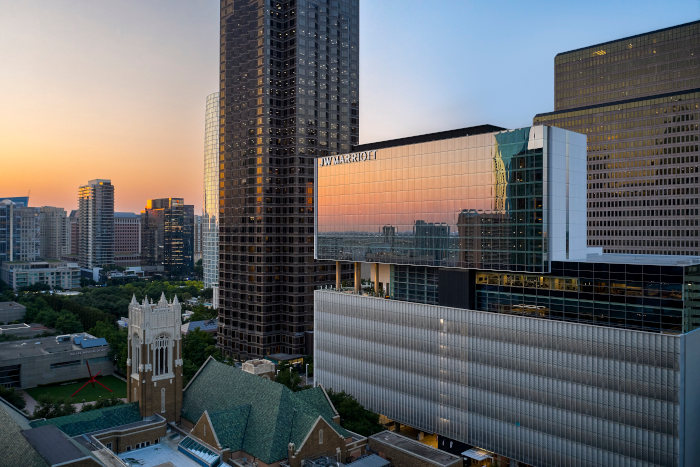With the return of business travel and large meetings in 2023, all accompanied by the growth in air capacity, the global hotel industry has regained its momentum. The figures presented by the analysis firm STR at the Global Meeting Exchange event, recently organized by Accor, can only confirm this. Last May, the average occupancy rate worldwide was only 4% down from the level reached in 2019, compared to -20% in June 2021. As for room prices, travelers were able to notice this a little all over the world: they began to exceed what had been done before covid since last year, reaching + 25% in Europe and the Middle East last June.
As often slower to restart, luxury hotel occupancy has returned to 93% of what it was in 2019 – it was only 84% last year -, while the upscale segment is at 95% of its performance before, compared to 88% in 2022. At the same time, the mid-range, at 98%, and the economy, with 96%, are almost in line with their pre-covid levels
Similarly, since the start of the year, some regions have done as well or even better than in 2019, such as Central America with a TO 7% higher, while Sub-Saharan Africa and South America are on par with the pre-covid period. In North America (-4%) or in Europe and North Africa (both -5%), hotel occupancy is also holding up well. There remain two global sub-regions where attendance is still far from pre-pandemic levels: Australia and Oceania (-8%) and Asia (-9%), with international air traffic to these destinations being still far less than it could have been, explaining this or accentuating that.
But, and this is good news for hoteliers because of the importance of this market, the STR figures for Asia exclude China which, with a drop in attendance of -3%, is gradually returning to the game after long months of zero covid policy. A figure which marks a new momentum at the domestic level but which also opens up prospects internationally. While just under 150 million Chinese travelers are expected worldwide this year, STR expects nearly 250 million next year and more than 350 million travelers in 2025, thus exceeding the total reached before the pandemic.
Upward revisions
Enough to encourage hotel groups to be optimistic. However, the announcement by the sector leaders of their quarterly results shows that they already were. “The growth of our activity in the first half is very solid for all our brands and in all our markets,” said Sébastien Bazin, CEO of the Accor group. This momentum should continue over the coming months, driven by continued strong demand for both leisure and business travel.” A favorable trend that allows the French hotelier to revise its growth forecasts upwards, with growth in revenue per room (RevPAR) “now expected at the top of the range between 15% and 20%” for the financial year. 2023.
The American groups are in unison with, for example, a RevPAR which should increase by 10% to 12% compared to 2022 at Hilton. As for Marriott, its worldwide RevPAR in the second quarter increased by 13.5%, “thanks to significant growth in all our international regions, where RevPAR increased by 39%”, commented Anthony Capuano, the group’s CEO. For the rest of the year, the group expects growth to remain higher internationally than in the United States and Canada, “where we are seeing a return to more normal patterns“, notes the Marriott group in its press release. Although, as Marriott found, group travel saw revenue increase 10% from 2022, while “business traveler revenue also saw strong year-over-year growth.” ‘other, thanks to strong growth in average daily rates’.
The STR analyst also notes growth which has tended to run out of steam over the weeks in the United States since the beginning of 2023. A sort of return to normal. Or rather to a new normal, marked in particular by the effects of “work from home”. With the trivialization of telework, the traditionally busy days, from Tuesday to Friday, tend to lose some of their luster, while the slow days like Sundays and Mondays are seeing increasing demand. A trend that hasn’t – yet? – crossing the Atlantic, since in Europe, demand is still growing during the week, but also, and this is newer, on Sundays and Mondays.
Room for improvement
Another observation, and which offers room for improvement for the European hotel industry, is that group demand has not yet returned to the same level as it can be in the United States. Hotels with more than 400 rooms, for example, posted an average occupancy rate of 64% last May, compared to 70% in May 2019. Depending on the week, this shift in group demand – offset by the growth in individual customers – can reach 20%-30% vs 2019.
A positive point for the major cities of Europe, but also Asia, STR expects demand to exceed that of 2019 very soon, and certainly in the first quarter of 2024. The main European destinations, long penalized by the pandemic, are regaining their role engine. Paris, London, Madrid, Rome, Athens, Lisbon, Warsaw, Dublin, Edinburgh, Budapest: all these cities recorded a clear increase in revenue per room, of 20% and more, compared to the reference year 2019. Which is less the case in Benelux and even more so in the DACH region, the Germanic zone.
This article is originally published on voyages-d-affaires.com


